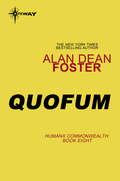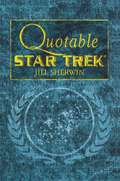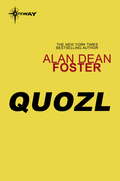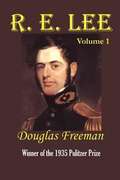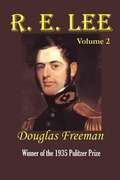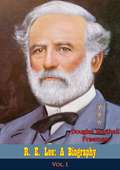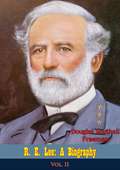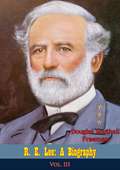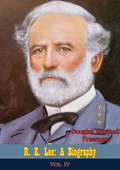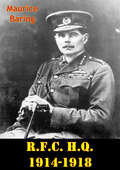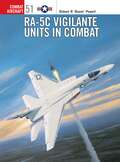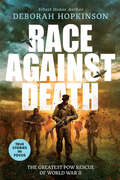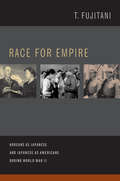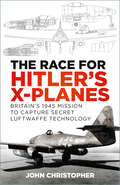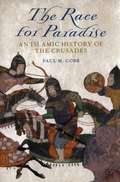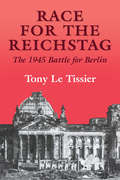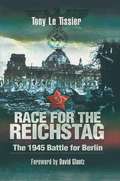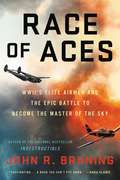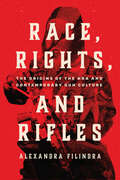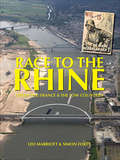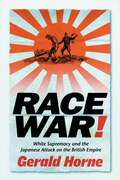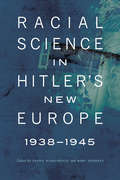- Table View
- List View
Quofum
by Alan Dean FosterThe Humanx Commonwealth: Book Eight.The mission to planet Quofum to investigate unknown flora and fauna is supposed to be a quickie for Captain Boylan and his crew. The first surprise is that Quofum, which seems to regularly slip in and out of existence, is actually there when they arrive. The second surprise is Quofum's wild biodiversity: the planet is not logical, ordered or rational. But the real shock comes when the crew members not only find a killer in their midst but discover that their spaceship is missing - along with all means of communication. Of course, the marooned team-mates know nothing about the Great Evil racing toward the galaxy, or about Flinx, the only person with half a chance to stop it. Nor do they know that Quofum could play a crucial role in defeating the all devouring monster from beyond.
Quotable Star Trek (Star Trek)
by Jill Sherwin"...Good words. That's where ideas begin."-- Dr. David Marcus to Admiral James T. Kirk, Star Trek® II: The Wrath of Khan It makes us wonder. It makes us smile. But most of all, it makes us think.More than any other single aspect, Star Trek is defined by the strength of its ideas. For decades this television and movie phenomenon has reached out to its audience, spanning generations and inspiring them not simply with the power of its voice, but with the meaning behind it.Quotable Star Trek demonstrates the truly universal appeal of Gene Roddenberry's extraorinary creation. Words of wit, wisdom, and compelling insight applicable to everyday life from The Original Series, Star Trek: The Next Generation®, Star Trek: Deep Space Nine®, Star Trek Voyager®, and eight Star Trek motion pictures have been meticulously researched and collected in one volume. Intensely thought-provoking and thoroughly entertaining, Quotable Star Trek has something for everyone, and is a must-have resource for every devoted fan.
Quozl
by Alan Dean FosterThe Quozl knew they'd love the third planet from the sun.But it never occurred to them that anyone lived there . . .
The R. A. F. At War (Time-Life)
by Ralph BarkerIn a furious debate in the House of Commons in July 1934, Winston Churchill alarmed his colleagues with the news that Germany's Adolf Hitler was secretly building an air arm that within two more years would be able to overwhelm Britain's Royal Air Force--unless the RAF expanded at once. Over the protests of members who denied there was any real threat of war, Parliament voted to keep the RAF at parity with the growing German air force. This would mean building up the RAF's manpower and replacing its aged fleet of biplanes with faster monoplanes. The task would not be easy.
R. E. Lee: A Biography, Vol. 1
by Douglas S. Freeman<p>R. E. Lee by Douglas Southall Freeman was the recipient of the 1935 Pulitzer Prize for Literature. It was a richly deserved honor, for Freeman's biography of the distinguished Virginian went on to become one of the most celebrated of all American biographies, a favorite of General George Marshall and President Dwight Eisenhower, among many others. Since his death, thousands of American soldiers have sought to emulate Lee's example of virtue, courage, and duty. <p>This four-volume masterpiece traces Lee's life from his birth in 1807 at the ancestral Lee home of Stratford to his final years as the president of Washington College in Lexington, Virginia, where he was buried in 1870. Volume One carries us from Lee's childhood through his youth as a cadet at West Point, his slow but steady advance in the US Army Corps of Engineers, his spectacular record under General Winfield Scott during the Mexican War, his superintendency of West Point, and so on up to the point where Lee has made the difficult and painful decision to resign his commission in the US Army in order to remain with his beloved state of Virginia...for him, his "nation". <p>After organizing the state's defenses and attempting unsuccessfully to keep Western Virginia within the control of Virginia, Lee is sent southward to inspect and build up the coastal defenses all the way to Florida. The volume ends with Lee's recall to Richmond as the Federal army under McClellan mounts its first invasion of Virginia.</p>
R. E. Lee: Volume 2
by Douglas S. FreemanDescribes the initial Confederate successes during the first year of the Civil War.
R. E. Lee: A Biography, Vol. I (R. E. Lee: A Biography #1)
by Douglas Southall FreemanFollowing the immediate critical success of Lee’s Dispatches, author Douglas Southall Freeman was approached by New York publisher Charles Scribner’s Sons and invited to write a biography of Robert E. Lee. He accepted, and his research of Lee was exhaustive: he evaluated and cataloged every item about Lee, and reviewed records at West Point, the War Department, and material in private collections. In narrating the general’s Civil War years, he used what came to be known as the “fog of war” technique—providing readers only the limited information that Lee himself had at a given moment. This helped convey the confusion of war that Lee experienced, as well as the processes by which Lee grappled with problems and made decisions.R. E. Lee: A Biography was published in four volumes in 1934 and 1935. In its book review, The New York Times declared it “Lee complete for all time.” Historian Dumas Malone wrote, “Great as my personal expectations were, the realization far surpassed them.” In 1935, Freeman was awarded the Pulitzer Prize for his four-volume biography.Freeman’s R. E. Lee: A Biography remains the authoritative study on the Confederate general.
R. E. Lee: A Biography, Vol. II (R. E. Lee: A Biography #2)
by Douglas Southall FreemanFollowing the immediate critical success of Lee's Dispatches, author Douglas Southall Freeman was approached by New York publisher Charles Scribner's Sons and invited to write a biography of Robert E. Lee. He accepted, and his research of Lee was exhaustive: he evaluated and cataloged every item about Lee, and reviewed records at West Point, the War Department, and material in private collections. In narrating the general's Civil War years, he used what came to be known as the "fog of war" technique--providing readers only the limited information that Lee himself had at a given moment. This helped convey the confusion of war that Lee experienced, as well as the processes by which Lee grappled with problems and made decisions.R. E. Lee: A Biography was published in four volumes in 1934 and 1935. In its book review, The New York Times declared it "Lee complete for all time." Historian Dumas Malone wrote, "Great as my personal expectations were, the realization far surpassed them." In 1935, Freeman was awarded the Pulitzer Prize for his four-volume biography.Freeman's R. E. Lee: A Biography remains the authoritative study on the Confederate general.
R. E. Lee: A Biography (R. E. Lee: A Biography #3)
by Douglas Southall FreemanFollowing the immediate critical success of Lee's Dispatches, author Douglas Southall Freeman was approached by New York publisher Charles Scribner's Sons and invited to write a biography of Robert E. Lee. He accepted, and his research of Lee was exhaustive: he evaluated and cataloged every item about Lee, and reviewed records at West Point, the War Department, and material in private collections. In narrating the general's Civil War years, he used what came to be known as the "fog of war" technique--providing readers only the limited information that Lee himself had at a given moment. This helped convey the confusion of war that Lee experienced, as well as the processes by which Lee grappled with problems and made decisions.R. E. Lee: A Biography was published in four volumes in 1934 and 1935. In its book review, The New York Times declared it "Lee complete for all time." Historian Dumas Malone wrote, "Great as my personal expectations were, the realization far surpassed them." In 1935, Freeman was awarded the Pulitzer Prize for his four-volume biography.Freeman's R. E. Lee: A Biography remains the authoritative study on the Confederate general.
R. E. Lee: A Biography, Vol. IV (R. E. Lee: A Biography #4)
by Douglas Southall FreemanFollowing the immediate critical success of Lee's Dispatches, author Douglas Southall Freeman was approached by New York publisher Charles Scribner's Sons and invited to write a biography of Robert E. Lee. He accepted, and his research of Lee was exhaustive: he evaluated and cataloged every item about Lee, and reviewed records at West Point, the War Department, and material in private collections. In narrating the general's Civil War years, he used what came to be known as the "fog of war" technique--providing readers only the limited information that Lee himself had at a given moment. This helped convey the confusion of war that Lee experienced, as well as the processes by which Lee grappled with problems and made decisions.R. E. Lee: A Biography was published in four volumes in 1934 and 1935. In its book review, The New York Times declared it "Lee complete for all time." Historian Dumas Malone wrote, "Great as my personal expectations were, the realization far surpassed them." In 1935, Freeman was awarded the Pulitzer Prize for his four-volume biography.Freeman's R. E. Lee: A Biography remains the authoritative study on the Confederate general.
R.F.C. H.Q. 1914-1918 [Illustrated Edition]
by Maurice BaringIncludes Aerial Warfare During World War I Illustrations Pack with 115 maps, plans, and photos."Maurice Baring made an unlikely soldier but during the First World War, at the age of forty, he obtained a commission and became Private Secretary to Hugh Trenchard, Commander of the Royal Flying Corps in France, and, later on, creator of the Royal Air Force. Drawn from letters and diaries, Baring describes the momentous war years that forged the flying services. The embryo RAF was lucky to have such an observant and eloquent chronicler of its early years.General Foch said 'There never was a Staff Officer in any country, in any century like Major Maurice Baring'.When first published in 1920, it was hailed 'as one of the few war books that will survive'."-Print ed.
RA-5C Vigilante Units in Combat
by Robert PowellDeveloped from the A-5 nuclear bomber and used in a reconnaissance role, the RA-5C Vigilante was the largest and fastest aeroplane ever to operate from the deck of an aircraft carrier. During the Vietnam War (1955-1975) it sustained the highest loss ratio of any American aircraft in that conflict. This volume includes compelling accounts of combat missions over key communist targets, where crews dodged Surface-to-Air Missiles (SAMs) and anti-aircraft fire to secure all-important mission photographs. Written by a Vigilante combat veteran this book is crammed full of action-packed first-hand accounts.
Race Against Death: The Greatest POW Rescue of World War II (Scholastic Focus)
by Deborah HopkinsonA thrilling account of the most daring World War II rescue mission, liberating hundreds of American prisoners of war.Following the bombing of Pearl Harbor, America entered World War II, and a new theater of battle opened up in the Pacific. But US troops, along with thousands of Filipino soldiers who fought alongside them, were overtaken in the Philippines by a fiercely determined Japanese navy, and many Americans and Filipino fighters were killed or captured.These American and Filipino prisoners of war were forced to endure the most horrific conditions on the deadly trek known as the Bataan Death March. Then, the American servicemen who were held captive by the Japanese military in Cabanatuan Camp and others in the Philippines, faced beatings, starvation, and tropical diseases, and lived constantly under the threat of death.Unable to forget their comrades’ fate and concerned that these POWs would be brutally murdered as the tides of war shifted in the Pacific, the US Army Rangers undertook one of the most daring and dangerous rescue missions of all time. Aided by the “Angels of the Underground,” the Sixth Ranger Battalion and courageous Filipino guerrilla soldiers set out on an uncertain and treacherous assignment.Often called the Great Raid, this remarkable story remains largely forgotten.Sibert Honor author Deborah Hopkinson presents an extraordinary and unflinching look at the heroic servicemen and women who courageously weathered the worst of circumstances and conditions in service to their country, as well as those who answered the call to save their fellow soldiers.
Race, Empire and First World War Writing
by Santanu DasThis volume brings together an international cast of scholars from a variety of fields to examine the racial and colonial aspects of the First World War, and show how issues of race and empire shaped its literature and culture. The global nature of the First World War is fast becoming the focus of intense inquiry. This book analyses European discourses about colonial participation and recovers the war experience of different racial, ethnic and national groups, including the Chinese, Vietnamese, Indians, Maori, West Africans and Jamaicans. It also investigates testimonial and literary writings, from war diaries and nursing memoirs to Irish, New Zealand and African American literature, and analyses processes of memory and commemoration in the former colonies and dominions. Drawing upon archival, literary and visual material, the book provides a compelling account of the conflict's reverberations in Europe and its empires and reclaims the multiracial dimensions of war memory.
Race for Empire: Koreans as Japanese and Japanese as Americans during World War II
by T. FujitaniRace for Empire offers a profound and challenging reinterpretation of nationalism, racism, and wartime mobilization during the Asia-Pacific war. In parallel case studies--of Japanese Americans mobilized to serve in the United States Army and of Koreans recruited or drafted into the Japanese military--T. Fujitani examines the U.S. and Japanese empires as they struggled to manage racialized populations while waging total war. Fujitani probes governmental policies and analyzes representations of these soldiers--on film, in literature, and in archival documents--to reveal how characteristics of racism, nationalism, capitalism, gender politics, and the family changed on both sides. He demonstrates that the United States and Japan became increasingly alike over the course of the war, perhaps most tellingly in their common attempts to disavow racism even as they reproduced it in new ways and forms.
The Race for Hitler's X-Planes: Britain's 1945 Mission to Capture Secret Luftwaffe Technology
by John ChristopherDuring World War 2, Hitler’s engineers had pioneered an incredible array of futuristic secret weapons, from the Me 262, the first operational jet fighter, to the deadly V2 inter continental ballistic missile. With the Third Reich shattered and lying in ruins, in the summer of 1945, the Allies launched a frantic race to grab what they saw as the justifiable spoils of war. The Americans and Russians in particular were anxious to secure not only the aircraft and the research and production facilities, but also the key German scientists and engineers.This Nazi technology would define the balance of power in the phoney peace of the Cold War era, launching an arms race that shaped our modern world for decades to come. But what of Britain’s role in this supermarket sweep? The Race for Hitler’s X-Planes tells the untold story of the British mission to Germany.
The Race for Paradise: An Islamic History of the Crusades
by Paul M. CobbIn The Race for Paradise, Paul M. Cobb offers a new history of the confrontations between Muslims and Franks we now call the "Crusades," one that emphasizes the diversity of Muslim experiences of the European holy war. There is more to the story than Jerusalem, the Templars, Saladin, and the Assassins. Cobb considers the Arab perspective on all shores of the Muslim Mediterranean, from Spain to Syria. In the process, he shows that this is not a straightforward story of warriors and kings clashing in the Holy Land, but a more complicated tale of border-crossers and turncoats; of embassies and merchants; of scholars and spies, all of them seeking to manage a new threat from the barbarian fringes of their ordered world. When seen from the perspective of medieval Muslims, the Crusades emerge as something altogether different from the high-flying rhetoric of the European chronicles: as a cultural encounter to ponder, a diplomatic chess-game to be mastered, a commercial opportunity to be seized, and as so often happened, a political challenge to be exploited by ambitious rulers making canny use of the language of jihad.
Race for the Reichstag: The 1945 Battle for Berlin (Soviet (Russian) Military Experience #No. 4)
by Tony, Le Tissier MBEThe soldiers of the Red Army identified the Reichstag as the victor's prize to be taken in Berlin. This account of the battle lays the many myths created by Soviet propaganda after the event to rest and details what exactly happened as the Red Army and the Allies raced to be the first at the Reichstag.
Race for the Reichstag: The 1945 Battle for Berlin (Soviet (russian) Military Experience Ser. #No. 5)
by Tony Le TissierThe acclaimed historian&’s classic account of the Battle for Berlin offers unprecedented detail and insight into the final days of WWII in Europe. This authoritative study dispels the myths created by Soviet propaganda and describes the Red Army&’s final offensive against Nazi Germany in graphic detail. For the Soviets, Berlin—and the Reichstag in particular—was seen as the ultimate prize. Stalin had initially promised Berlin to Marshal Zhukov. But after Zhukov blundered a preliminary battle, Stalin allowed Marshal Koniev, Zhukov's rival, to launch one of his powerful tank armies at the city. The advancing Soviet forces were confronted by a desperate, inadequate German defense. General Weidling's panzer corps was dragged into the city in a futile attempt to prolong the existence of the Third Reich, whose leaders squabbled and schemed in their underground shelters. Ten days later, after the suicides of Hitler and Goebbels, the survivors had to choose between breakout and surrender. Drawing on a wide range of Soviet sources and unprecedented access to German archival and memoir materials, Race for the Reichstag brings into startling focus the bitter fight for the last patch of soil under Wehrmacht control.
Race of Aces: WWII's Elite Airmen and the Epic Battle to Become the Master of the Sky
by John Bruning<P><P>The astonishing untold story of the WWII airmen who risked it all in the deadly race to become the greatest American fighter pilot. In 1942, America's deadliest fighter pilot, or "ace of aces" -- the legendary Eddie Rickenbacker -- offered a bottle of bourbon to the first U.S. fighter pilot to break his record of twenty-six enemy planes shot down. <P><P>Seizing on the challenge to motivate his men, General George Kenney promoted what they would come to call the "race of aces" as a way of boosting the spirits of his war-weary command. What developed was a wild three-year sprint for fame and glory, and the chance to be called America's greatest fighter pilot. The story has never been told until now. Based on new research and full of revelations, John Bruning's brilliant, original book tells the story of how five American pilots contended for personal glory in the Pacific while leading Kenney's resurgent air force against the most formidable enemy America ever faced. <P><P>The pilots -- Richard Bong, Tommy McGuire, Neel Kearby, Charles MacDonald and Gerald Johnson -- riveted the nation as they contended for Rickenbacker's crown. As their scores mounted, they transformed themselves from farm boys and aspiring dentists into artists of the modern dogfight. But as the race reached its climax, some of the pilots began to see how the spotlight warped their sense of duty. They emerged as leaders, beloved by their men as they chose selfless devotion over national accolades. <P><P>Teeming with action all across the vast Pacific theater, Race of Aces is a fascinating exploration of the boundary between honorable duty, personal glory, and the complex landscape of the human heart.
Race, Rights, and Rifles: The Origins of the NRA and Contemporary Gun Culture (Chicago Studies in American Politics)
by Alexandra FilindraAn eye-opening examination of the ties between American gun culture and white male supremacy from the American Revolution to today. One-third of American adults—approximately 86 million people—own firearms. This is not just for protection or hunting. Although many associate gun-centric ideology with individualist and libertarian traditions in American political culture, Race, Rights, and Rifles shows that it rests on an equally old but different foundation. Instead, Alexandra Frilindra shows that American gun culture can be traced back to the American Revolution when republican notions of civic duty were fused with a belief in white male supremacy and a commitment to maintaining racial and gender hierarchies. Drawing on wide-ranging historical and contemporary evidence, Race, Rights, and Rifles traces how this ideology emerged during the Revolution and became embedded in America’s institutions, from state militias to the National Rifle Association (NRA). Utilizing original survey data, Filindra reveals how many White Americans —including those outside of the NRA’s direct orbit—embrace these beliefs, and as a result, they are more likely than other Americans to value gun rights over voting rights, embrace antidemocratic norms, and justify political violence.
Race to the Rhine: Liberating France and the Low Countries 1944-45 (Then And Now Ser.)
by Simon Forty Leo MarriottTravel across the battlefields of WWII with this beautiful book combining historical images, full-color aerial photography, and informative text.In June, 1944, Allied forces invaded Nazi-occupied France, beginning a sweep of fierce battles that would eventually liberate Western Europe. With aerial photography, historic images, maps, and other illustrations, Race to the Rhine brings readers to the fateful grounds where men sacrificed their lives for freedom.The destruction of German forces in Normandy’s Falaise pocket was a decisive victory: by September, British troops were in Ghent and Liege; Canadian forces liberated Ostend, and in northeast France, Patton’s Third Army was moving rapidly to the German border. The liberation of the Low Countries would not prove as straightforward, however. Operation Market Garden—Montgomery’s brave thrust toward the Rhine at Arnhem—ended in failure with over 6,000 paratroopers captured.In late October, belated operations began to clear the Scheldt Estuary and open the port of Antwerp to the Allies. Belgium was almost free of the Nazi yoke and the Netherlands looked likely to be cleared before Christmas. Then, on December 16, came a major German counter-offensive in the Ardennes. It turned out to be Hitler’s last try: the American defenders held, and in the spring the Rhine was finally gained.Perfect for the armchair traveler or for those who want a historic guide as they visit significant sites, Race to the Rhine supplies essential information on the places that best represent the battles today.
Race War!: White Supremacy and the Japanese Attack on the British Empire
by Gerald HorneJapan's lightning march across Asia during World War II was swift and brutal. Nation after nation fell to Japanese soldiers. How were the Japanese able to justify their occupation of so many Asian nations? And how did they find supporters in countries they subdued and exploited? Race War! delves into submerged and forgotten history to reveal how European racism and colonialism were deftly exploited by the Japanese to create allies among formerly colonized people of color. Through interviews and original archival research on five continents, Gerald Horne shows how race played a key--and hitherto ignored--;role in each phase of the war.During the conflict, the Japanese turned white racism on its head portraying the war as a defense against white domination in the Pacific. We learn about the reverse racial hierarchy practiced by the Japanese internment camps, in which whites were placed at the bottom of the totem pole, under the supervision of Chinese, Korean, and Indian guards--an embarrassing example of racial payback that was downplayed by the defeated Japanese and the humiliated Europeans and Euro-Americans. Focusing on the microcosmic example of Hong Kong but ranging from colonial India to New Zealand and the shores of the U.S., Gerald Horne radically retells the story of the war. From racist U.S. propaganda to Black Nationalist open support of Imperial Japan, information about the effect of race on U.S. and British policy is revealed for the first time. This revisionist account of the war draws connections between General Tojo, Malaysian freedom fighters, and Elijah Muhammed of the Nation of Islam and shows how white racism encouraged and enabled Japanese imperialism. In sum, Horne demonstrates that the retreat of white supremacy was not only driven by the impact of the Cold War and the energized militancy of Africans and African-Americans but by the impact of the Pacific War as well, as a chastened U.S. and U.K. moved vigorously after this conflict to remove the conditions that made Japan's success possible.
Rachel's Secret: an engrossing and heartwarming novel of friendship and the bonds which tie us together from bestselling author Susan Sallis
by Susan SallisFrom the pen of multi-million copy seller and Sunday Times bestselling author Susan Sallis comes beautifully written, enthralling and captivating novel that asks whether friendships really can endure through thick and thin. Readers of Rosamunde Pilcher, Maeve Binchy and Fiona Valpy will not be disappointed.'Sallis's West Country novel has the feel of Mary Wesley and character insight that is all her own' -- Daily Mail'Sallis brings out the innate warmth and sometimes unpredictability of the human psyche. This compelling tale will not disappoint' -- Lancashire Evening Post'Excellent read, very enjoyable' - ***** Reader review'Wonderful' - ***** Reader review'I love her books and the way that she takes you right into the story...You can tell I am a big fan!' - ***** Reader review'Brilliant, I couldn't put it down.' - ***** Reader review*********************************************************************FRIENDS SINCE CHILDHOOD, THEY THOUGHT NOTHING COULD COME BETWEEN THEM...1943: two schoolgirls, Rachel and Meriel, best friends, amuse themselves by tracking down imaginary German spies. It all seems a harmless way of whiling away the long school holidays, until their game turns into a frightening reality, the consequences of which affect their whole lives.Rachel becomes a reporter on the local paper while Meriel, a GI bride, goes to live in Florida.But the bonds which hold them together can never be broken, as the secrets and scandals which first surfaced in those far-off wartime days eventually come to light.
Racial Science in Hitler's New Europe, 1938-1945 (Critical Studies in the History of Anthropology)
by Anton Weiss-WendtIn Racial Science in Hitler&’s New Europe, 1938–1945, international scholars examine the theories of race that informed the legal, political, and social policies aimed against ethnic minorities in Nazi-dominated Europe. The essays explicate how racial science, preexisting racist sentiments, and pseudoscientific theories of race that were preeminent in interwar Europe ultimately facilitated Nazi racial designs for a &“New Europe.&”The volume examines racial theories in a number of European nation-states in order to understand racial thinking at large, the origins of the Holocaust, and the history of ethnic discrimination in each of those countries. The essays, by uncovering neglected layers of complexity, diversity, and nuance, demonstrate how local discourse on race paralleled Nazi racial theory but had unique nationalist intellectual traditions of racial thought. Written by rising scholars who are new to English-language audiences, this work examines the scientific foundations that central, eastern, northern, and southern European countries laid for ethnic discrimination, the attempted annihilation of Jews, and the elimination of other so-called inferior peoples.
